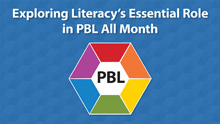 As November quickly comes to a close, the International Reading Association reflects on the month dedicated to project-based learning tips and techniques. Focusing on key skills in communication, collaboration, and critical thinking, PBL is often cross-curricular, incorporating technology and driving questions to connect students to the world outside their classrooms, and, of course, relies on literacy in all subject areas.
As November quickly comes to a close, the International Reading Association reflects on the month dedicated to project-based learning tips and techniques. Focusing on key skills in communication, collaboration, and critical thinking, PBL is often cross-curricular, incorporating technology and driving questions to connect students to the world outside their classrooms, and, of course, relies on literacy in all subject areas.
Our Twitter #IRAchat with the Buck Institute for Education’s Suzie Boss and Myla Lee revolved around incorporating inquiry-based learning, engaging students in reading, writing, and listening skills, and taking part in analyzing text and finding evidence to support statements. The chat also highlighted how students learn with each other and, more importantly, from one another. Contributors to the chat stressed the importance of teamwork, finding texts that benefit all readers, and modeling dynamic learning with technology.
Nell Duke, PBL advocate and author of Inside Information: Developing Powerful Readings and Writers of Informational Text Through Project-Based Instruction, said PBL is critical to taking classroom teaching to the next level of efficacy. Her book is co-published by IRA and Scholastic.
“Providing a purpose for students' reading and writing beyond simply learning to read and write or practicing reading and writing supports students' development,” Duke said. “PBL offers one way to provide such a purpose. PBL provides an overall framework into we can place many valuable instructional moves, such as teaching comprehension strategies and teaching students to tailor their writing to their audience.”
The PBL teaching style is gaining more attention and momentum from educators, but there’s still a long way to go to implement the practice into schools. It is important that we continue to revisit PBL techniques and look to see how we can apply PBL strategies into education across all ages and all subjects.
“We have more to do as a field to sort out what constitutes PBL,” says Duke. “We need to sort out how best to involve literacy instructional techniques that we know to be effective, such as text structure instruction and teaching editing strategies, in project-based approaches. Finally, we need to find ways to make PBL more practical for more teachers.”
Reading Today Online posts included a check-in on an innovative school program starting in Missouri, the Maker Movement used in a school library, and tips from educators on how to effectively use PBL in the classroom.
Morgan Ratnor is a communications intern for International Reading Association.